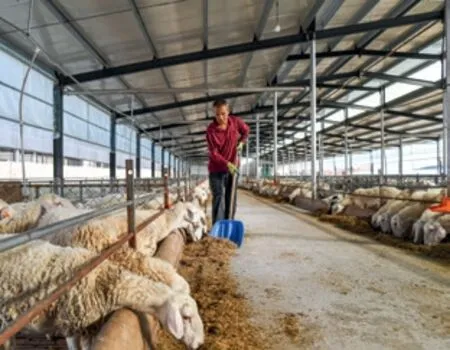Road to Renewal Zuoquan County’s pursuit of self-development through promoting cooperatives and boosting industries
2022-10-04ByTaoXing
By Tao Xing
Traveling into Zuoquan County in Shanxi Province, one will see energetic change in full swing—many places in the county are under construction, from rural cooperatives to factories and cultural tourism bases.The county, once called Liaoxian, was renamed in September 1942 after Zuo Quan, four months after his death in the region as he and other comrades attempted to break out of encirclement by the Japanese invading army. Zuo was a general with the Eighth Route Army, the larger of the two major Chinese communist forces that fought the Japanese invasion from 1937 to 1945.
The county’s mountains provided a natural defensive barrier during the war, but also posed a natural obstacle that hindered residents’ access to the outside world, a factor leading to regional poverty. Fortunately, the county moved out of absolute poverty in 2019 under China’s overall poverty alleviation program. China had eliminated absolute poverty by late 2020 and has now shifted its focus to all-round rural revitalization, a new stage in agricultural and rural development.
The leadership of the county called on locals to carry forward the revolutionary spirit and further transform the area into a more modern one during a ceremony marking the 80th anniversary of the county’s renaming on September 18.
The cooperative’s contribution
The rural collective economy is an important part of China’s socialist public ownership economy.Rural cooperatives have played an important role in poverty alleviation in Zuoquan and are now contributing to rural revitalization.
One farming cooperative typically consists of members from one or several villages. The co-op is jointly managed by its members who then share the profits. Simply put, the cooperative provides villages and farmers with an entrepreneurial platform for commercial production.
A new co-op model came to Xiakou Village in the county in 2018 in the form of a crab farming company. The cooperative rents land from the village to run a 13-hectare crab farm, at an annual rental fee of 80,000 yuan ($11,457).
The crabs produced by the co-op are sold, under a long-term supply contract, to a supermarket in Taiyuan, capital city of Shanxi, Zhang Songxin, head of Matian Town, toldon September 17. Xiakou is an administrative village underneath Matian.
The farm has provided more than 30 jobs to locals, allowing every one of them to increase their individual yearly income by 10,000 yuan ($1,432).Comparatively, the annual per-capita disposable income of the county’s urban population, such as the residents of the county seat, was 32,259 yuan ($4,581)in 2021, according to county government statistics. Furthermore, the cooperative also pays each of 20 low-income families an additional dividend of 1,000 yuan ($143) every year.
While Xiakou has benefited from the crab cooperative, Hanwang Town of Zuoquan has introduced a similar undertaking—a sheep farming base. Several villages in the town have entered the co-op, together purchasing sheep for breeding at the base and then selling mutton and by-products. It also generates new job opportunities. The base now brings in an annual revenue of 2 million yuan ($310,000), according to one of its staff members.

Workers package walnut oil at Shunkang Natural Agricultural Products Co. Ltd.,a food processing enterprise in Matian Town of Zuoquan County, Shanxi Province,on September 17
These cooperatives have motivated villagers to develop specialty agriculture and boost their income, especially against the backdrop of rapid rural population aging, Bai Juan, head of the county’s Guaier Town, told.
With the youth migrating to the urban areas in pursuit of better employment, many of Guaier’s walnut orchards have been neglected. Setting up a village company can lead to unified orchard cultivation and locals can then sell the walnuts, Bai explained. To grow trade, a village enterprise can delegate its business to outside professional agricultural enterprises.
Over 670 of 2,144 hectares of the town’s walnut orchards are now under the unified management of outside enterprises, according to Bai. “First we make sure these agricultural industries are alive, then make them grow,” the official added.

A farmer feeds sheep at a farm in Hanwang Town, Shanxi Province’s Zuoquan, on September 16
Industrial appeal
Stepping into a new stage of rural revitalization requires Zuoquan to rely more on its own independent development. Shi Yong, Secretary of the Communist Party of China Zuoquan County Committee, stressed the importance of developing industries.
“Industries can bring in both capital and people,” he said at a meeting with visiting reporters from China International Communications Group (CICG) on September 16. Since 2002, CICG has been sending its employees to Zuoquan,first to participate in China’s poverty alleviation drive (2012-20) and now to contribute their share to rural revitalization. Under China’s pairing-up assistance model, public entities in economically developed areas, ranging from universities to public institutions such as CICG, come to the aid of less developed regions.
Upgrading existing industries is one method for revitalization. Zuoquan is famous for its walnut trees. In recent years, the county has extended the industrial chain from just supplying raw materials to actual processing.Shunkang Natural Agricultural Products Co. Ltd.in Matian operates an integrated business in walnut purchasing, processing and selling. It produces a range of related products, from nuts ready for consumption to walnut oil.
With an investment of 7.92 million yuan ($1.12 million) in infrastructure and facilities in 2021,the company now has the capacity to process 13,500 tons of walnuts per year and is expected to generate an annual output value of 320 million yuan ($45.7 million), Kang Jianzhong, founder of Shunkang, told reporters.
Zuoquan is introducing many new industries. For example, the Zuoquan Latex Industry Park, still under construction, will feature 160 production lines with a total annual output value of over 3.2 billion yuan ($457 million)once finished, making it one of the largest latex producing bases in China. The park is set to produce balloons, condoms and medical gloves,Xia Zhiqiang, project manager of the park, told reporters on September 17.
Zuoquan has the advantages of low labor cost and convenient cargo transportation, according to Xia. The whole project is expected to provide 10,000 jobs and pay annual taxes in the amount of 348 million yuan ($50 million), Xia added.
Additionally, the county’s existing power plant, located close to the park, can provide enough electricity and steam for latex production,another park staff member told.
“The first 14 lines are expected to begin production in October,” the staff member said.Thousands of locals have been trained for the upcoming operation, he added.
Zuoquan is also setting up painting and photography bases to attract more visual artists to the area. With its illustrious natural scenery and historical heritage, the county is cultivating cultural tourism to boost the local economy.
With the industries generating new prospects for its high-quality development, Zuoquan is ready to enter a new chapter. BR
(,)
